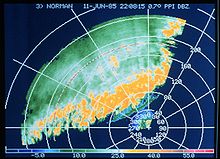| This article needs additional citations for verification. Please help improve this article by adding citations to reliable sources. Unsourced material may be challenged and removed. Find sources: "DBZ" meteorology – news · newspapers · books · scholar · JSTOR (May 2023) (Learn how and when to remove this message) |

Decibel relative to Z, or dBZ, is a logarithmic dimensionless technical unit used in radar.It is mostly used in weather radar, to compare the equivalent reflectivity factor (Z) of a remote object (in mm per m) to the return of a droplet of rain with a diameter of 1 mm (1 mm per m). It is proportional to the number of drops per unit volume and the sixth power of drops' diameter and is thus used to estimate the rain or snow intensity. With other variables analyzed from the radar returns it helps to determine the type of precipitation. Both the radar reflectivity factor and its logarithmic version are commonly referred to as reflectivity when the context is clear. In short, the higher the dBZ value, the more likely it is for severe weather to occur in the form of precipitation.
Values above 20 dBZ usually indicate falling precipitation.
Principle
The radar reflectivity factor (Z) of precipitation is dependent on the number (N0) and size (D) of reflectors (hydrometeors), which includes rain, snow, graupel, and hail. Very sensitive radars can also measure the reflectivity of cloud drops and ice. For an exponential distribution of reflectors, Z is expressed by:
As rain droplets have a diameter on the order of 1 millimetre, Z is in mmm (μm). By dividing Z with the equivalent return of a 1 mm drop in a volume of a meter cube (Z0) and using the logarithm of the result (because the values vary greatly from drizzle to hail), one obtains the logarithmic reflectivity LZ, in dBZ:
dBZ values can be converted to rainfall rates (R) in millimetres per hour using the Marshall-Palmer formula:

| LZ (dBZ) | R (mm/h) | R (in/h) | Intensity |
|---|---|---|---|
| 5 | 0.07 | < 0.01 | Trace accumulation or mist |
| 10 | 0.15 | < 0.01 | Trace accumulation or mist |
| 15 | 0.3 | 0.01 | Trace accumulation |
| 20 | 0.6 | 0.02 | Light rain |
| 25 | 1.3 | 0.05 | Light rain |
| 30 | 2.7 | 0.10 | Light to moderate rain |
| 35 | 5.6 | 0.22 | Moderate rain |
| 40 | 11.53 | 0.45 | Moderate to heavy rain |
| 45 | 23.7 | 0.92 | Heavy rain |
| 50 | 48.6 | 1.90 | Heavy rain, small hail possible |
| 55 | 100 | 4 | Very heavy rain, hail possible. |
| 60 | 205 | 8 | Very heavy rain, hail likely. |
| 65 | 421 | 16.6 | Very heavy rain, hail very likely, large hail possible. |
Other quantities
The definition of Z above shows that a large number of small hydrometeors will reflect as one large hydrometeor. The signal returned to the radar will be equivalent in both situations, so a group of small hydrometeors is virtually indistinguishable from one large hydrometeor on the resulting radar image. The reflectivity image is just one type of image produced by a radar. Using it alone, a meteorologist could not tell with certainty the type of precipitation and distinguish any artifacts affecting the radar return.
In combination with other information gathered by the radar during the same scan (dual polarization products and phase shifting due to the Doppler effect), meteorologists can distinguish between hail, rain, snow, biologicals (birds, insects), and other atmospheric phenomena.
References
- "Weather Glossary: D's". National Weather Service. Retrieved January 9, 2019.
- ^ M. K. Yau and R. R. Rogers (1989). Short Course in Cloud Physics, Third Edition. Butterworth-Heinemann. p. 190. ISBN 0750632151.
- "RIDGE Radar Frequently Asked Questions". Archived from the original on 2019-03-31. Retrieved 2019-08-08.
- "NWS NEXRAD". Archived from the original on January 13, 2016. Retrieved January 13, 2016.
| Decibel suffixes (dB) | |
|---|---|


